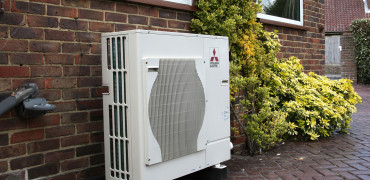Friday the 8th of February was the end of The Future Homes Standard consultation period.
This saw the government call on the construction industry to feedback its thoughts on how we achieve the massive reduction in carbon emissions needed, along with increasing efficiency from each new home by increasing the use of renewable technologies such as air source heat pumps.
Remember that we need to build at least 300,000 new home a year to help with the shortage of housing and we will not get anywhere near zero carbon if we continue to use gas.
Originally published by the Ministry of Housing Communities and Local Government (MHCLG) on 1st October 2019, The Future Homes Standard included proposals to require, amongst other things, an 80% reduction in carbon emissions from new dwellings by 2025.
It was also accompanied by a proposed interim step in 2020 with two suggested options:
- a reduction of either 20% or
- a 31% in carbon emissions.
“The Code would have produced zero carbon homes in 2016”
A code for living
For me and many others though, these proposals simply do not go far enough, and there is a real fear that even these ‘modest’ plans will eventually be watered down.
If we look back to the plans detailed in the former ‘Code for Sustainable Homes’, then we were already supposed to be building zero carbon homes in 2016 – What happened there then?
The Code was first introduced in 2006 and is an environmental assessment method for rating and certifying the performance of new homes in United Kingdom.
It was pushing a national standard for use in the design and construction of new homes with a view to encouraging continuous improvement in sustainable home building.
In 2015 the Government withdrew the Code and consolidated some of its standards into the Building Regulations.
An end to gas and oil
At that stage, social housing was required to meet Code Level 4, which made the fitting of gas boilers in new-build virtually impossible and also encouraged the retrofitting of renewables into refurbished properties to replace coal, oil and direct electric.
This is a major part of the reason that social housing has been so quick to adopt renewable heating and has led the way in the adoption of air source heat pumps.
This is reflected in the September 2019 report from the Sustainable Energy Association called ‘Social Housing: Leading the Way to Net Zero’.
And the housebuilders?
With the Code, the pressure was always on social housing to lead the way, so the major housebuilders were one step behind, at Code Level 3 when it was abandoned.
This means that even today, housebuilders are able to build new estates with gas boilers, even though there is now a significant and rapidly growing awareness amongst consumers of the need to do something for the long-term, especially in our homes.
I genuinely believe we are at a pivotal time in consumer awareness and I do think we will start to see people demand more sustainable options for their homes as awareness of the climate crisis grows.
But without this demand, and with no real legislative ‘sticks’, why would the major housebuilders look to install renewable technology that they are currently unfamiliar with, and that they don’t yet have to?
There are some pioneering housebuilders who are ahead of the rest, but if we are to have any chance of hitting our net zero targets, then we actually need the Building Regulations to be beefed up to tackle this area so that all of the others have to follow. . . and soon.
Both sticks and carrots
As we wait for the results of The Future Homes Standard consultation, and look at what government will take on board from the industry, we have to find ways to encourage wider adoption of renewable heating and fast, whether that is through legislation to enforce or incentives to encourage.
We know that air source heat pumps can make a huge difference to housing stock emissions and help developers achieve new standards.
We also know they can be readily retrofitted into the older homes that also must become part of the solution but this may also involve other measures such as an increase in thermal efficiency. The retrofit market therefore remains both a major challenge and a significant opportunity.
Yet the renewable heat incentive (which has never applied to new-build) is ending next year and, as yet, we know nothing of any replacement or other scheme to encourage the take up of renewables.
There’s lots to be done and lots of opportunity to make a difference. The very least we should expect from our leaders and policy makers is that the revisions to Part L must not be dumbed down.
Max Halliwell is communications manager for Heating and Ventilation



